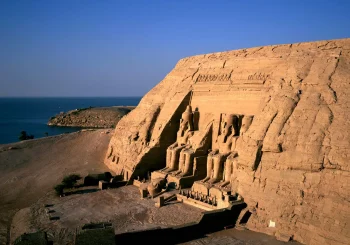Granite catches the light and a felaha looks across the Cairo University Bridge. She is one of two figures immortalized in sculpture, known as Nahdet Misr, or Egypt’s Renaissance: woman and sphinx, a pair who summarize the essence of Egypt at a glance.
The statue was initially inaugurated in Ramses Square in 1928, later moved to where it is now – the Nahdet Misr Street, which borrowed its name from the sculpture. It has become a Giza monument, and a site that has witnessed both protest and victory over the years.
Mahmoud Mukhtar (1891 – 1934) brought Nahdet Misr to life, sculpting the monument “[o]n the heels of World War I and the wake of Egypt’s 1919 Revolution.” Mukhtar had a vision of Egypt that stretched past the British occupation, and Nahdet Misr was meant to embody that struggle for independence. In essence, it personified the modern, national aspirations many Egyptians had at the time.

Nahdet Misr became a vehicle for responding to sociopolitical change. Mukhtar believed that by personifying Egypt, the emotional link between a nation’s overdue awakening and national identity could be bridged. Bringing together two emblems of the Egyptian experience – a modest faleha who shoulders households, and the ever-daunting sphinx – Mukhtar succeeded.
With her left, the felaha pulls aside her veil, symbolizing a yet-unseen vision of Egypt – a revival, or many. Her right arm drapes over the sphinx, a nod to a history spanning seven millennia. Risen to a high seat, the sphinx was sculpted to intimidate, a powerful vision denoting pride. Nahdet Misr is a marriage of the humble and grand, the past and present. Its pyramidal shape is one of resolve and calculation, a strong front put up against an unknown future.
Nahdet Misr may have been born in the early 20th century, but it symbolizes a greater cornerstone ideology: Egyptians believe in hard work, and better days to come.






Comments (5)
[…] مشهورة وتاريخية: الأقصر تحفة فنية ميراث. إنه متحف في الهواء الطلق في مصر ، مدينة مليئة بالتاريخ والجمال والنزاهة. إنه يجلس على نهر النيل ، مما يطمس خطوط الصدع بين مصر الحديثة والعصور القديمة ، على غرار القاهرة نهضة مصر. […]
[…] Famous and famously historical: Luxor is a masterpiece of legacy. It is Egypt’s open-air museum, a city ripe with history and beauty and integrity. It sits on the Nile, blurring the fault lines between modern Egypt and antiquity, not unlike Cairo’s Nahdet Misr. […]